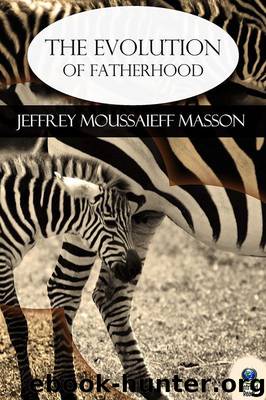The Evolution of Fatherhood by Jeffrey Moussaieff Masson

Author:Jeffrey Moussaieff Masson [Masson, Jeffrey Moussaieff]
Language: eng
Format: epub
Tags: Parenting
Publisher: Untreed Reads Publishing
Published: 2013-03-15T00:00:00+00:00
In species in which the male is visibly different from the female, it is usually the male who is more conspicuous, having a distinctive color pattern or song. In these species, I have been assured, the females are less susceptible to imprinting. (I am not sure how one would determine this, however, since it must be very difficult to determine the gender of ducklings or goslings.) For example, among ducks and geese the sensitive periods for sexual imprinting correspond closely to the duration of parental care. So it is longer in geese than in ducks. This means that the infant bird is susceptible to imprinting only while it is a member of the family group. The sensitive period in some birds is over well before the chicks leave the nest and mix with members of other species, so there is little chance they would sexually imprint on a member of another species. Obviously, the fact that the sensitive period is brief evolved as a safety device so that the young will not form attachments where they do not belong. 9
When I was a small child, I was present when two baby ducks hatched. They saw me, and for a whole year after that, they would follow me wherever I went, even to school. I was fascinated, but I was also proud, as if these ducks had recognized some special paternal (it was really maternal, but I did not know that at the time) quality in me. Only as an adult do I now see that these cross-fostering experiments, as they are called, have a sinister side. Birds were not meant to imprint on us. They do so not out of an excess of love, but faute de mieux—for want of anything better. Maybe we should not exploit this natural capacity to love, which was meant for their own species, not for us. I wonder how much of the bond between parrots and their “owners” is real as opposed to artificially induced by this sort of imprinting.
Ratite Birds
Among the male birds who take most responsibility for sitting on nests (brooding) are the ratite birds found in South America, Australia, and Africa—ostriches, rheas, cassowaries, and emus. The wild ostrich, Struthio camelus,is now found only in Africa. (Many people think of these birds as being from Australia, but they are an introduced bird there, raised only on farms.) These are huge, flightless, two-toed terrestrial birds with long necks and powerful legs. They are the largest living birds as well as the heaviest (at six feet tall, they can weigh up to 285 pounds). Each foot is armed with a formidable, sturdy, ten-centimeter-long flattened claw on the thick inner toe, making the birds strong enough to kill a lion. Given its stride of eight feet, it is not surprising that it is an extraordinarily fast runner. Both male and female ostriches sprint at up to forty-five miles per hour. Their huge eyes (the better to see enemies) are the largest of any terrestrial vertebrate.
Download
This site does not store any files on its server. We only index and link to content provided by other sites. Please contact the content providers to delete copyright contents if any and email us, we'll remove relevant links or contents immediately.
The Incest Diary by Anonymous(7428)
The Lost Art of Listening by Michael P. Nichols(7170)
The Rosie Project by Graeme Simsion(5854)
We Need to Talk by Celeste Headlee(5422)
Beartown by Fredrik Backman(5372)
Ego Is the Enemy by Ryan Holiday(4967)
Hunger by Roxane Gay(4683)
Suicide Notes by Michael Thomas Ford(4659)
I Love You But I Don't Trust You by Mira Kirshenbaum(3710)
Mummy Knew by Lisa James(3527)
Crazy Is My Superpower by A.J. Mendez Brooks(3210)
Not a Diet Book by James Smith(3158)
Girl, Wash Your Face by Rachel Hollis(3129)
Toxic Parents by Susan Forward(3128)
The Complete Idiot's Guide to Coping With Difficult People by Arlene Uhl(3068)
Name Book, The: Over 10,000 Names--Their Meanings, Origins, and Spiritual Significance by Astoria Dorothy(2847)
The Hard Questions by Susan Piver(2825)
The Social Psychology of Inequality by Unknown(2774)
The Gaslight Effect by Dr. Robin Stern(2673)
